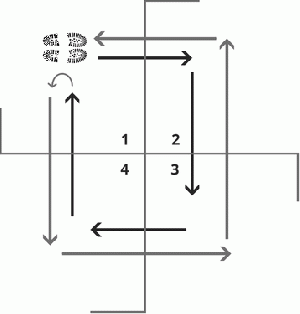Four Square Step Test: Difference between revisions
Candace Goh (talk | contribs) No edit summary |
Candace Goh (talk | contribs) No edit summary |
||
| Line 27: | Line 27: | ||
* Two trials are then performed, and the better time (in seconds) is taken as the score. | * Two trials are then performed, and the better time (in seconds) is taken as the score. | ||
* Timing starts when the first foot contacts the floor in Square 2 and finishes when the last foot comes back to touch the floor in Square 1. | * Timing starts when the first foot contacts the floor in Square 2 and finishes when the last foot comes back to touch the floor in Square 1. | ||
* Instructions: “Try to complete the sequence as fast and as safely as possible without touching the sticks. Both feet must make contact with the floor in each square. If possible, face forward during the entire sequence.” | * Instructions: “Try to complete the sequence as fast and as safely as possible without touching the sticks. Both feet must make contact with the floor in each square. If possible, face forward during the entire sequence.”<ref>Dite W, Temple VA. A clinical test of stepping and change of direction to identify multiple falling older adults. Archives of physical medicine and rehabilitation. 2002 Nov 1;83(11):1566-71.</ref><ref>Blennerhassett JM, Jayalath VM. The Four Square Step Test is a feasible and valid clinical test of dynamic standing balance for use in ambulant people poststroke. Archives of physical medicine and rehabilitation. 2008 Nov 1;89(11):2156-61.</ref> | ||
* Repeat a trial if the subject: | * Repeat a trial if the subject: | ||
| Line 40: | Line 40: | ||
* 4 canes | * 4 canes | ||
== Time to | == Time to Administer == | ||
Less than five minutes | Less than five minutes | ||
Revision as of 10:35, 25 March 2018
Original Editor - Candace Goh
Top Contributors - Candace Goh, Kim Jackson, Lucinda hampton, Vidya Acharya, George Prudden and Chelsea Mclene
Objective
[edit | edit source]
The Four Square Step Test (FSST) is used to assess dynamic stability and the ability of the subject to step over low objects forward, sideways, and backward.[1]
Intended Population[edit | edit source]
- Older adults/geriatrics
- Stroke
- Parkinson's Disease
- Vestibular Disorders
- Limb Loss/Amputation
Method of Use[edit | edit source]
Test Description:
- The subject is required to sequentially step over four canes set-up in a cross configuration on the ground.
- At the start of the test, the subject stands in Square 1 facing Square 2.
- The aim is to step as fast as possible into each square with both feet in the following sequence: Square 2, 3, 4, 1, 4, 3, 2, 1 (clockwise to counterclockwise)
- Test procedure may be demonstrated, one practice trial is allowed prior to administering the test.
- Two trials are then performed, and the better time (in seconds) is taken as the score.
- Timing starts when the first foot contacts the floor in Square 2 and finishes when the last foot comes back to touch the floor in Square 1.
- Instructions: “Try to complete the sequence as fast and as safely as possible without touching the sticks. Both feet must make contact with the floor in each square. If possible, face forward during the entire sequence.”[2][3]
- Repeat a trial if the subject:
- Fails to complete the sequence successfully
- Loses balance
- Makes contact with the cane
- Subjects who are unable to face forward during the entire sequence may turn before stepping into the next square and are timed accordingly.
Equipment[edit | edit source]
- Stopwatch
- 4 canes
Time to Administer[edit | edit source]
Less than five minutes
Evidence[edit | edit source]
The FSST may be an effective and valid tool for measuring dynamic balance and the subject's fall risk. It has been shown to have strong correlations with other measures of balance and mobility with good reliability shown in a number of populations.[4]
References[edit | edit source]
- ↑ Shirley Ryan Ability Lab. Rehabilitation measure: four square step test. www.sralab.org/rehabilitation-measures/four-step-square-test (accessed 12 March 2018).
- ↑ Dite W, Temple VA. A clinical test of stepping and change of direction to identify multiple falling older adults. Archives of physical medicine and rehabilitation. 2002 Nov 1;83(11):1566-71.
- ↑ Blennerhassett JM, Jayalath VM. The Four Square Step Test is a feasible and valid clinical test of dynamic standing balance for use in ambulant people poststroke. Archives of physical medicine and rehabilitation. 2008 Nov 1;89(11):2156-61.
- ↑ Moore M, Barker K. The validity and reliability of the four square step test in different adult populations: a systematic review. Systematic reviews. 2017 Dec;6(1):187. https://systematicreviewsjournal.biomedcentral.com/articles/10.1186/s13643-017-0577-5 (accessed 12 March 2018).







